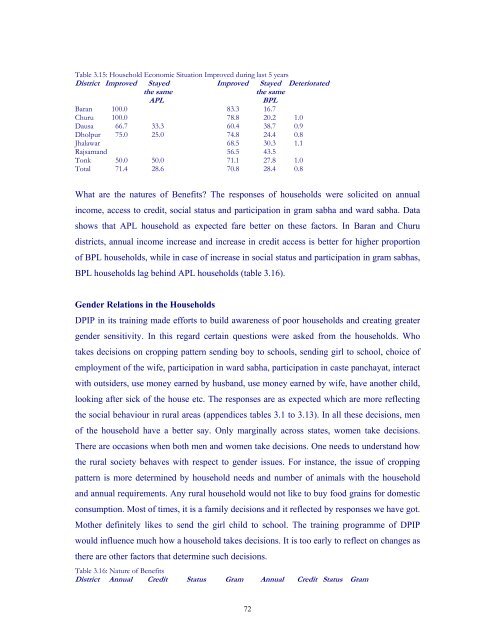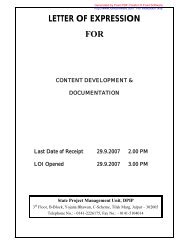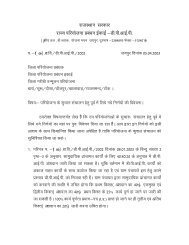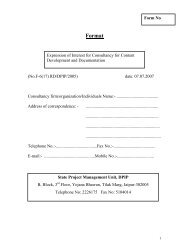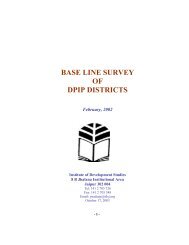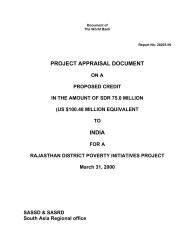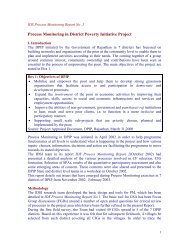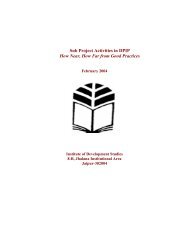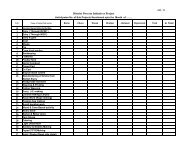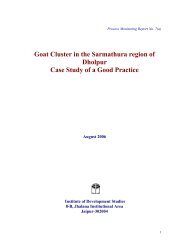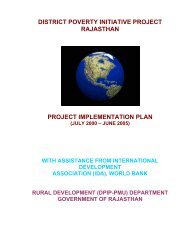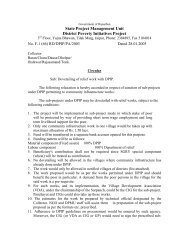Impact Assessment of the District Poverty Initiative Project Rajasthan
Impact Assessment of the District Poverty Initiative Project Rajasthan
Impact Assessment of the District Poverty Initiative Project Rajasthan
You also want an ePaper? Increase the reach of your titles
YUMPU automatically turns print PDFs into web optimized ePapers that Google loves.
Table 3.15: Household Economic Situation Improved during last 5 years<br />
<strong>District</strong> Improved Stayed Improved Stayed Deteriorated<br />
<strong>the</strong> same<br />
<strong>the</strong> same<br />
APL<br />
BPL<br />
Baran 100.0 83.3 16.7<br />
Churu 100.0 78.8 20.2 1.0<br />
Dausa 66.7 33.3 60.4 38.7 0.9<br />
Dholpur 75.0 25.0 74.8 24.4 0.8<br />
Jhalawar 68.5 30.3 1.1<br />
Rajsamand 56.5 43.5<br />
Tonk 50.0 50.0 71.1 27.8 1.0<br />
Total 71.4 28.6 70.8 28.4 0.8<br />
What are <strong>the</strong> natures <strong>of</strong> Benefits The responses <strong>of</strong> households were solicited on annual<br />
income, access to credit, social status and participation in gram sabha and ward sabha. Data<br />
shows that APL household as expected fare better on <strong>the</strong>se factors. In Baran and Churu<br />
districts, annual income increase and increase in credit access is better for higher proportion<br />
<strong>of</strong> BPL households, while in case <strong>of</strong> increase in social status and participation in gram sabhas,<br />
BPL households lag behind APL households (table 3.16).<br />
Gender Relations in <strong>the</strong> Households<br />
DPIP in its training made efforts to build awareness <strong>of</strong> poor households and creating greater<br />
gender sensitivity. In this regard certain questions were asked from <strong>the</strong> households. Who<br />
takes decisions on cropping pattern sending boy to schools, sending girl to school, choice <strong>of</strong><br />
employment <strong>of</strong> <strong>the</strong> wife, participation in ward sabha, participation in caste panchayat, interact<br />
with outsiders, use money earned by husband, use money earned by wife, have ano<strong>the</strong>r child,<br />
looking after sick <strong>of</strong> <strong>the</strong> house etc. The responses are as expected which are more reflecting<br />
<strong>the</strong> social behaviour in rural areas (appendices tables 3.1 to 3.13). In all <strong>the</strong>se decisions, men<br />
<strong>of</strong> <strong>the</strong> household have a better say. Only marginally across states, women take decisions.<br />
There are occasions when both men and women take decisions. One needs to understand how<br />
<strong>the</strong> rural society behaves with respect to gender issues. For instance, <strong>the</strong> issue <strong>of</strong> cropping<br />
pattern is more determined by household needs and number <strong>of</strong> animals with <strong>the</strong> household<br />
and annual requirements. Any rural household would not like to buy food grains for domestic<br />
consumption. Most <strong>of</strong> times, it is a family decisions and it reflected by responses we have got.<br />
Mo<strong>the</strong>r definitely likes to send <strong>the</strong> girl child to school. The training programme <strong>of</strong> DPIP<br />
would influence much how a household takes decisions. It is too early to reflect on changes as<br />
<strong>the</strong>re are o<strong>the</strong>r factors that determine such decisions.<br />
Table 3.16: Nature <strong>of</strong> Benefits<br />
<strong>District</strong> Annual Credit Status Gram Annual Credit Status Gram<br />
72


